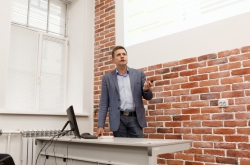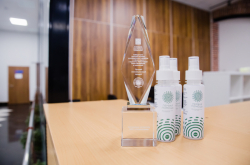How does one effectively work with distributed teams, motivate scientists and researchers and help employees develop themselves on a daily basis? According to Tatiana Tangisheva, head of personnel development at BIOCAD, innovative teams, unlike traditional businesses, require a different set of rules and regulations. This introduces new challenges to managers and personnel development specialists.
Speaking the same language
To become genuine partner to their scientists, personnel development specialists, managers and others in management positions at innovative companies have to not only be competent in their own field, but also possess enough basic knowledge to be able to speak the same language as the professionals they work with.
“Right now, basic education is the key for managers. 20 years ago, such a key skill was the English language – those who didn’t learn it, were left out in regards to both knowledge and career growth. Today, we have to improve our knowledge. It’s becoming too hard to “translate” the realities of the innovative environment into our “language”. You might not need these skills when working with traditional businesses, but innovations are different,” – notes Tangisheva.

Tatiana Tangisheva
Evidence-based decisions
Many have probably heard of “evidence-based medicine” – the idea that specific medical treatment solutions must be based on clear evidence of their effectiveness and safety, as proven by clinical testing. That means that the cornerstone of any medical decision isn’t the doctor’s personal experience or opinion, but the use of treatments the effectivity of which has been proven – such an approach entails searching and comparing information, conducting research and meta-analysis.
An evidence-based approach is being gradually adopted in other fields of work, says the expert. Today’s managers must be able to prove the correctness of their decision using statistical data and independent, verifiable research.
Newer technology, tougher tasks
Tangisheva adds that the use of a number of objective data analysis methods becomes a “dire necessity” for HR managers. It is no accident that more and more companies are starting to apply Big Data analysis when recruiting staff. According to Deloitte, approximately 40% of the world’s HR departments have started using such tools in the last year.
Technologies are gradually allowing recruiters to rid themselves of routine work. Why spend time on myriads of introductory calls when a robot can do it? This is what Vera is for – this Russian invention has recently won 1st place and $10,000 at the HR Tech World conference in Amsterdam – the world’s biggest event on innovative HR.

Vera the recruiter robot. Credit: robotvera.com
Vera is a recruiter robot based on AI technology, developed by the Russian startup Stafory. Vera seeks out resumes of potential candidates on various web resources. She then calls those who she deems fitting for the job and conducts a preliminary interview: the self-learning neural network can recognize human speech and maintain a dialogue. If the interview is successful, the robot sends a job description to the applicant and redirects them up the chain to a human HR manager.
“Vera’s success at HR Tech in Amsterdam show that our technology can satisfy the needs of today’s industry. Its main advantage is that it solves the age-old issue of many a recruiter, who used to have to waste their time and sanity on all those preliminary calls and interviews. Now, a robot can do it. Of course, it’s not perfect and she can’t fully talk like a human – and not all applicants are okay with using a chat box to talk. Still, it is a breakthrough that allows us to increase the effectiveness of human employees’ work,” – says the expert.
Culture of change
To form and develop innovative teams, it is vital to create a system that helps gives rise to a culture of development, innovation and change. If a company has instilled a culture of change, it can duly be called an innovative enterprise. What are the main criteria that define whether such a culture exists in a company?
First of all, in a culture of change, everyone believes in the predictability of progress. Prediction and calculations, in turn, are the tasks of leaders.
“We’re all familiar with this or that futuristic prognosis, but it is important to remember that some processes can indeed be predicted because we can figure out a clear dependency graph. It was impossible to predict, say, the emergence of social networks and how they would become the primary means of communication. However, we can predict qualitative changes and observe them – that is the task of an innovative company. We must seek out and implement in our work new knowledge from different areas. It’s important to remain inside a community in which new things are constantly appearing and to keep an eye on new developments,” – explains Tatiana Tangisheva.

Employee at BIOCAD. Credit: bigpicture.ru
Secondly, technological advancement depends on the competencies accumulated by a company’s staff and is a strategic advantage. Therefore the way its personnel training and development departments are structured and operated is crucial to an innovative company. In biotech, the events of the next decade can be predicted; a company like Rosatom needs to be able to predict the next 100-150 years of the industry, as the production cycle in their field lasts 120 years – the time from when a power facility is launched until it is shut down.
Finally, it’s important to remember that, thanks to electronic communications, teams are becoming more global, international. It’s a regular occurrence to have the same project being worked on by people from all over the planet. It’s important to preserve trust in innovative teams. To create that dynamic in a group, employees need to talk to each other from time to time – at BIOCAD, major meetings are arranged twice a year during which distributed teams from all over the world get to meet each other. At such events, staff can not only further discuss work-related matters, but to get to know each other in a less formal setting. This kind of interaction is a way to establish communication within a team and increase the employees’ trust and motivation.
Approaches to team management
Professional interest
When we meet with professionals interested in creating new things, the simplest thing we can do is let them show their knowledge – says Ms. Tangisheva. Major scientific conferences are suitable venues for such things. In early October, BIOCAD had organized a biotechnology conference, inviting scientists from all over Russia and their international colleagues. At the event, these people had the chance to discuss the science-industry relationship, showcase their projects and exchange experience.

Creating communities
Modern innovative companies can’t operate within a hierarchy that implies strict obedience to higher-ups. On the one hand, such a system is needed in large companies where the work process can’t be based simply on personal agreement. On the other hand, innovations can’t be made within a strict hierarchy. New ideas are born in non-formal environments, which is why a number of major innovative companies are interested in creating and maintaining such communities. There, a horizontal hierarchy is formed in which any employee without any special privileges can introduce an initiative and garner support.
Idea space
“Initiatives that are born inside communities can be supported in different ways. For example, we have the “Innovation Group” project at our company. At certain times and at a particular place, people are able to meet up and discuss their ideas. Another project - “Idea Space” – exists on our intranet website. Everyone can use it to propose an idea,” – explains Tangisheva.
First, these ideas are evaluated by relevant experts and are then put to a vote. If the initiative accumulates a majority of positive votes, the team will attempt to implement it.
Development-conducive environment
To help employees learn and share their knowledge, a proper environment is required, and the way it functions should be simple and understood by all team members. This idea is implemented at companies through the creation of internal education systems or corporate universities. Such a university was created at BIOCAD, too.
A corporate university provides an opportunity to maintain a company’s expertise. When staff travel to conferences and workshops, they bring back new knowledge that benefits not just them, but the entire enterprise.

PubMed. Credit: University of Michigan.
In addition, a web-resource from which expert knowledge can be gained is a familiar ground to scientists who are used to services such as Pubmed. For that reason, as part of BIOCAD’s corporate university, a database was created, similar to Pubmed in interface and how it presents information. Employees can quickly find their way around and sort information by topic, date, source respectability and other parameters. After a year of operation, the database grew by two thousand articles – enough to lay the groundwork for the company’s internal expertise.
The company also operates a project called the Guest Club. It involves meetings with top scientists and experts in biotechnology as well as other fields, which helps expand the employees’ worldview.
Gamification
The game form is the simplest and fastest way to implement development. That is why it is used in practically every training program these days. At BIOCAD, gamification made it possible to implement the Kanban project management system in just a few months. This Japanese system is based on due completion of projects and equal distribution of workload among employees. With this approach, the entire development process is made transparent to all team members. As new tasks appear, they are added to a list from which they can be chosen by a developer.

A board game based on Kanban. Credit: boardgamemeeplelady.com
“We’ve made a boardgame based on Kanban, letting people play out all the possible scenarios that can be implemented in such a system. It shows that even the form in which we structure the working process determines if the company will be innovative, if teams will move forward and whether they will feel comfortable there. Gamification is an opportunity to establish a pleasant, comfortable environment,” – says the expert.
The biotechnology company BIOCAD is Russia's leading innovative biotechnology company; it combines a world-class research and development center, ultra-modern pharmaceutical and biotechnological manufacturing facilities, as well as preclinical and clinical research infrastructure compliant with international standards. BIOCAD is one of the world’s few full-cycle drug development and manufacturing companies, from new molecule discovery and genetic engineering to large-scale commercial production and marketing support. It employs more than 1,300 people, of whom 500 are scientists and researchers. Offices and subsidiaries are located in the USA, Brazil, China, India and others.





